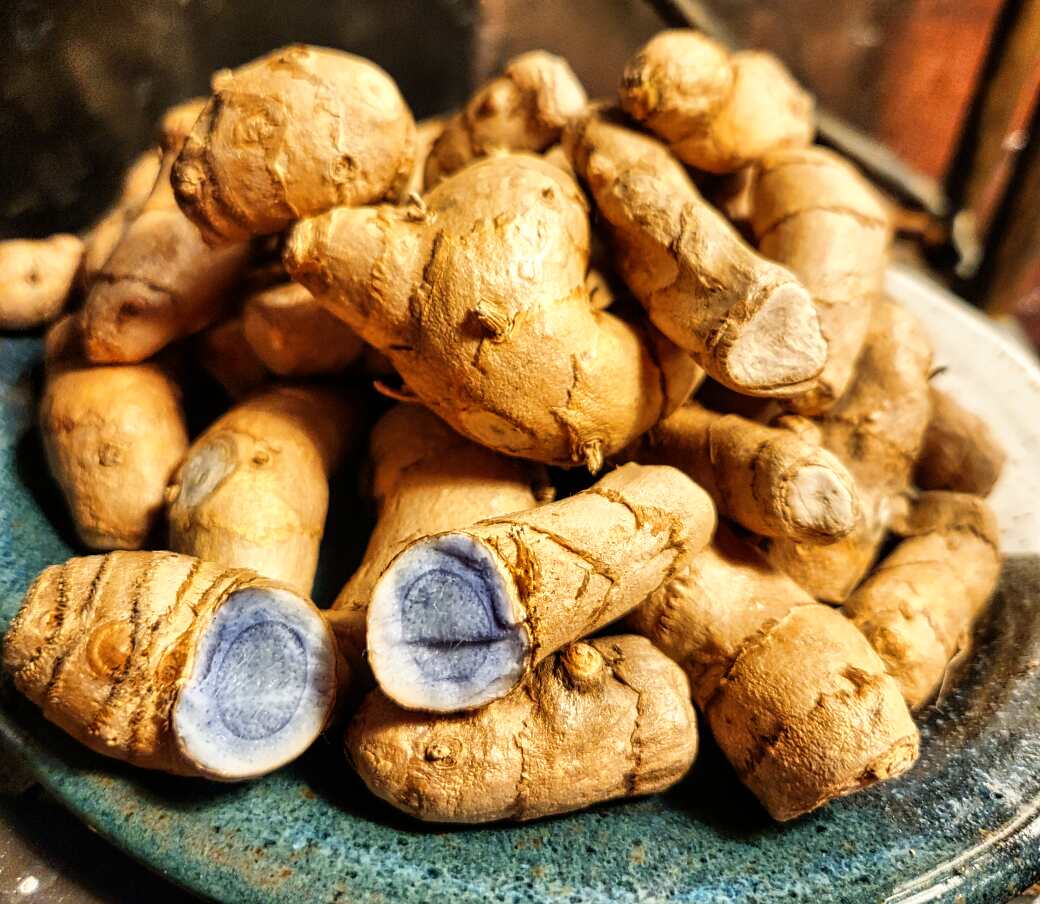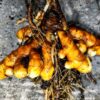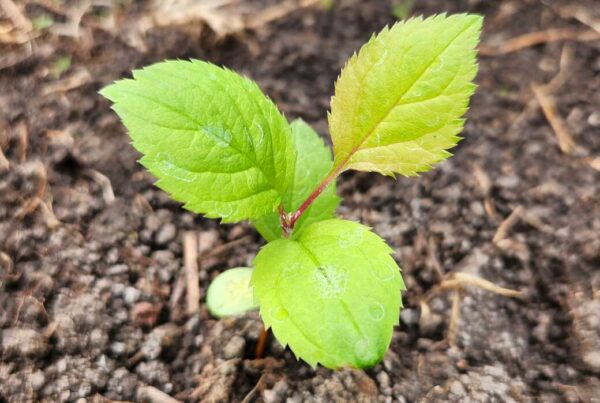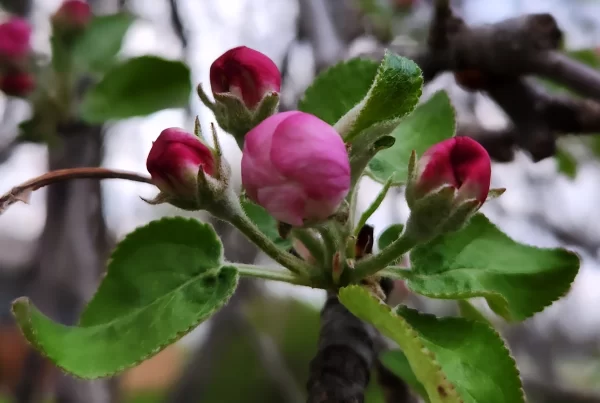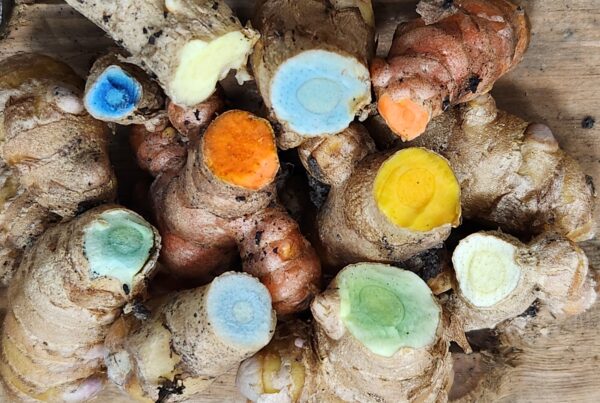Perhaps you love growing your own fresh herbs and spices. Maybe you were inspired on a recent trip to a tropical location. Perhaps you simply like a challenge. Whatever your interest in trying to grow turmeric in Iowa or another non-tropical location, I have a short answer and a long answer regarding turmeric’s ability to grow in Iowa.
The short answer is no. Turmeric will not grow outdoors in the Midwest. As you can see from the USDA plants database, turmeric is not native to the continental US. Depending on the source, turmeric is recommended for growing outdoors in zones 8 or 9 and above.
The long answer is yes. Turmeric will thrive in protected or indoor environments outside of its natural growing zones. However, production can very from excellent to poor, depending on the conditions. This post will detail how to grow turmeric well, in Iowa or other northern states.
If you live in Florida (or somewhere else relatively warm), try this link instead for growing turmeric outdoors.

Why Grow Turmeric
There are many reasons to grow turmeric in Iowa (or other northern states). For one, turmeric plants produce beautiful tropical foliage and flowers that look great in any room. Those with chronic pain may know turmeric rhizomes as a powerful anti-inflammatory. Turmeric may also help decrease pain after surgery, decrease some behavioral symptoms of Alzheimer’s Disease, and may be protective against cancer. If the above reasons weren’t enough, foodies love turmeric rhizomes as a delectable spice in Indian cooking, such as dal tadka.
Sourcing Turmeric Rhizomes
Turmeric rhizomes can be sourced from a reputable garden centers (try websites of those located in Southern locations, or contact us for availability). I have also planted turmeric rhizomes (curcuma longa and curcuma caesia) from local some Indian and Oriental markets with success. However, any turmeric I have purchased from a large grocer has molded or otherwise failed to sprout. Thus, I recommend purchasing your first turmeric rhizomes from a trusted nursery. There are many different colors of turmeric (curcuma longa) rhizomes, with orange being the easiest to find.

Growing Turmeric in Iowa
Turmeric appreciates warm, humid conditions and rich, well-draining soil. Unless you keep your house quite warm and moist, I recommend purchasing a plant heat mat and a warm steam vaporizer to create this type of environment. A bathroom with a south-facing window would be ideal.
Once you acquire turmeric rhizomes, plant them in a pot with fertile soil, about 1″ deep. If the rhizomes are already germinating, place the sprouting side up. If not, make sure at least one bud is facing up. Water regularly when the top of the soil is dry and be patient. Turmeric may take a couple of months to sprout. Of note, turmeric rhizomes will typically not sprout until the soil is consistently 75 degrees or above. This can be accomplished at normal room temperature by place your pot with turmeric on top of a plant heating mat.
Once your turmeric has sprouted, water whenever the soil is dry. Keep by a sunny window or under a grow light. Plants can be taken outside during the summer, but need protection from temperatures under 60 degrees Fahrenheit. (Be sure to check the nighttime low!) Turmeric prefers partial shade in warm climates, but can thrive in full sun in the north. Those in good soil and in larger planters are also likely to produce flowers, which will brighten your home for several days.
Turmeric needs at least seven months to develop large rhizomes. As noted above, most varieties of turmeric will begin to die when exposed to temperatures below 60 degrees for an extended period of time. Growing turmeric indoors will help your plants live long enough to produce.
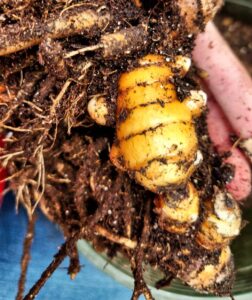
Harvesting Turmeric
Turmeric is ready for harvest when your plants die back and wilt. The majority of rhizome production occurs late in the season, do not dig up your plants until you the foliage is mostly dead. If in doubt, wait a bit longer. After digging up a plant, shake off the extra dirt, and then snap off the brightly colored rhizomes.
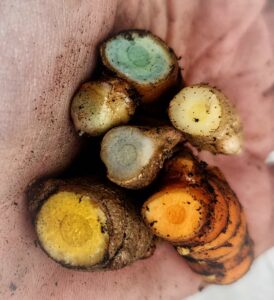
Turmeric rhizomes can be used in recipes, dried for use as medicinal supplements, or saved in a dry location to plant next spring. The spherical mother root can be saved to plant also. If saving for next planting season, be sure to protect the rhizomes/mother roots from freezing, or they will die. The mother roots generally sprout faster and are more likely to flower the following year than plants started directly from new rhizomes. Chop the stems off this root and add to your compost, or use as a nutritious mulch for other garden plants.
Improving Turmeric Yield
Poor turmeric yield when grown indoors is typically related to one of the following conditions:
- Planter too small for rhizome development. Turmeric rhizome development requires at least a square foot of soil (at least a 12″ pot).
- Soil too dry/too wet. Turmeric plants may survive drought, but rhizome development will be negatively impacted. On the other hand, soil that is consistently too wet will cause rhizomes to rot. To avoid either negative outcome, soil should be watered when dry to the touch.
- Poor soil. Optimal turmeric-growing soil should be well-draining (too much clay is bad), but nutrient rich (too much sand is bad).
- Growing season too short. As noted above, turmeric requires at least 7 months of growth for rhizome development. During this time, soil temperature should not drop below 65 degrees for an extended period of time, as this will cause foliage death. Placing the plant on a plant heat mat and near a hot steam vaporizer can help keep conditions warm, even if your house is a bit chilly. If you have a slightly higher budget, a grow tent (not required) can also help trap in heat and moisture.
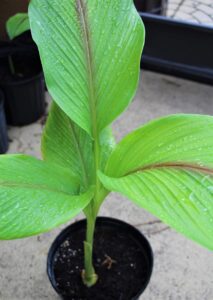
Bonus- it seems that some varieties of turmeric tolerate cool conditions better than others. This year my BKK orange turmeric continues to grow and thrive long after all other varieties have died back.
In summary, yes, you CAN grow turmeric in Iowa! Have you successfully grown turmeric in Iowa or another northern/midwestern location? If so, we’d love to hear from you in the comments below!
Want to learn more about different varieties of turmeric? Check out this post on identifying the many edible varieties.
Looking for turmeric rhizomes? We’re working on ramping up our production. Send us an email at [email protected] to be alerted when our turmeric rhizomes are back in stock!

